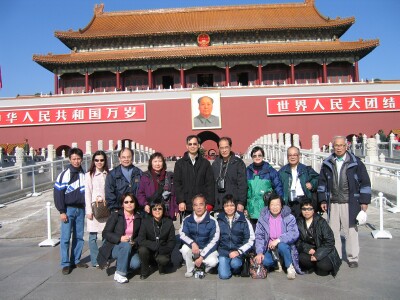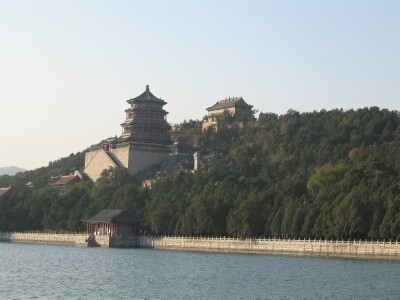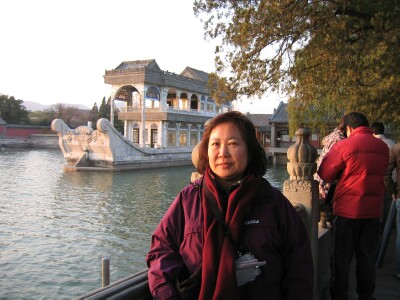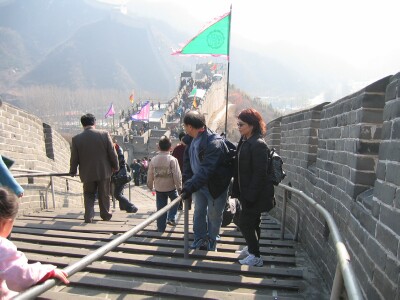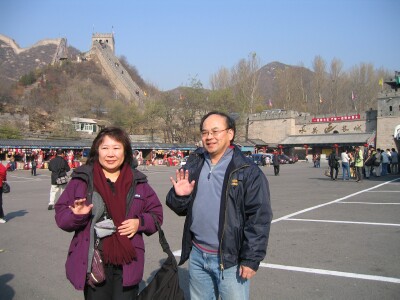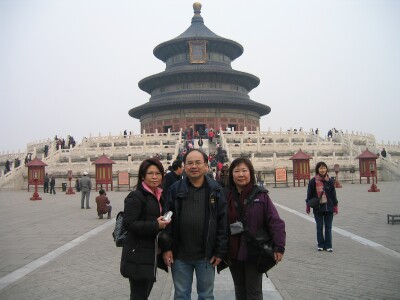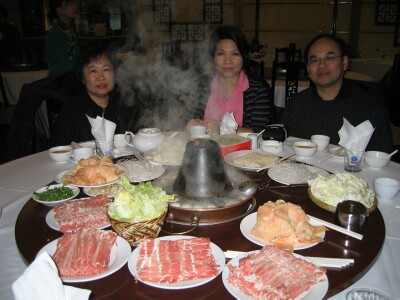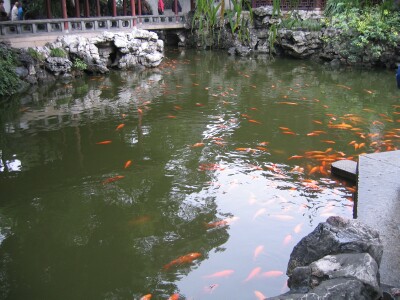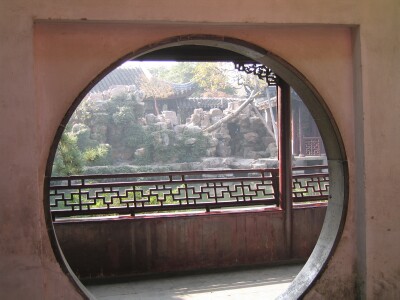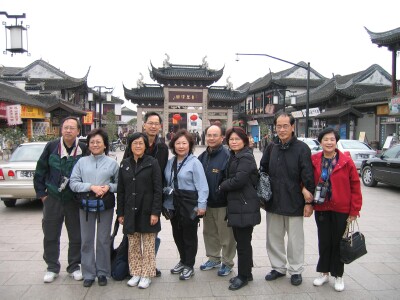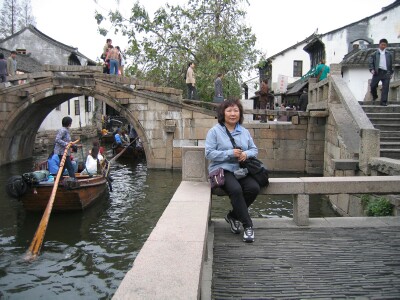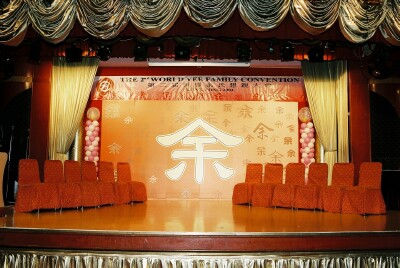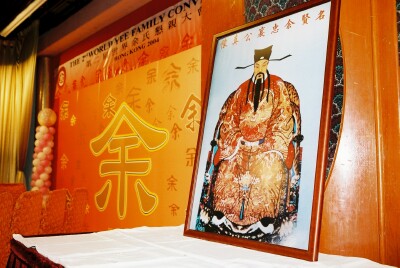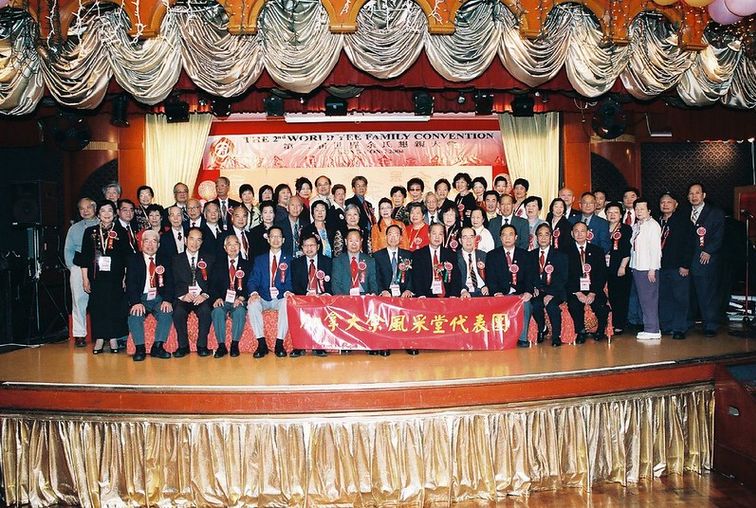|
Wednesday, November3rd, 2004 was a day to remember! My wife
Kitty and I, my sister Mrs. Mary Wong, and a group of
Vancouver Yee Fung Toy Society members: Mr. and Mrs. Jim Yee, Mr. and Mrs. Wing Yee, Mr.
and Mrs. Kin Man Yee, Mr. and Mrs. Wayne Yee, and Mr.
and Mrs. Jack Wong (Mr. Kin Man Yee’s son-in-law) joined
together at the Vancouver International Airport. We all were so enthusiastic
about embarking on a very memorable journey to China. This trip was a prelude to
our main travel objective of attending the Second
World Yee Family Convention in Hong Kong, from Monday, November 14th
through Wednesday, November 16th.
We boarded Air China Flight 992
around 1:15pm and, after a 12-hour flight, we arrived at Beijing’s Capital International Airport. It
was already late afternoon of November 4th in Beijing. We were immediately greeted by our friendly
tour guide, Ms Lucy Wang. Our tour bus drove for
one-and-one-half hours in rush-hour traffic before we
arrived at the Fook Wah Kwok Restaurant for
supper. After dining, we transferred to the
Millennium Hotel, a “5-Star” hotel. Lucy set up a
wakeup call for us, and suggested that we join her
around 7am for breakfast
at the Hotel Restaurant.
Friday, November 5th we enjoyed a very hearty
breakfast ‑ Continental Beijing style. Moments later, in
the Lobby, Lucy gathered us together and delivered our
itinerary. The weather was bright and sunny; a little
chilly perhaps. We piled on to our tour bus, which took
us to the Imperial Palace, also known as the Forbidden City "Gugong." A Beijing photographer, Ms. Chu,
accompanied us throughout the day and shooting both
video and still pictures. The Forbidden City’s scenery was as magnificent
and awe-inspiring as depicted in many Chinese movies!
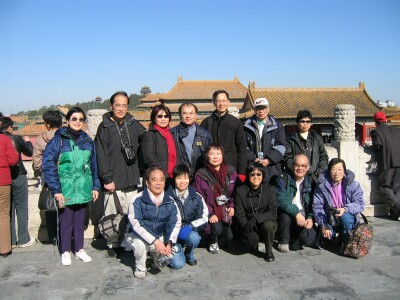
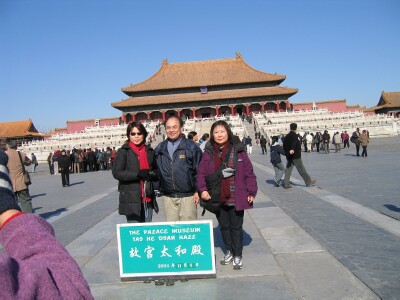 After visiting the Forbidden City’s Halls, we walked through Zhongshan Park and arrived at Tiananmen Square. Tiananmen Square is in the center of Beijing. It is said to be the biggest
square in the world: 880 meters from north to south and
500 meters from east to west. That’s a total area of
440,000 square meters, holding up to one million people!
The Tiananmen Gate Tower sits to the north with the
Five-Star Red Flag flying high on the square. The
Monument to the People's Heroes dominates the square’s
centre, and the Great Hall of the People and the Museum
of the Chinese Revolution and the Museum of Chinese History are to the east and west. The
Chairman Mao Memorial Hall and the Qianmen gate sit to
the south of the square.
We had lunch in a busy restaurant there. After lunch, we
boarded our bus and headed towards the Summer Palace, "Yiheyuan" (Garden of Good Health and Harmony), which was
originally a retreat for emperors to escape the scorching
summer heat of Beijing. The scenery was absolutely
beautiful. We walked through the 728 meter-long Covered
Painting Walkway, the longest walkway in the Chinese
gardens with over 14,000 traditional Chinese paintings on
its beams and crossbeams. We also saw the Marble Boat,
which was built for the 50th birthday celebration of
Empress Dowager Ci'x. This is where she enjoyed the hazy
scene over the lake on rainy days.
As the night sky
approached, Lucy advised that we would not have enough
time to visit the Tiantan
until another day. So, we boarded the bus once more,
arrived at a fairly classy restaurant, and dined on
“Peking Duck” as our main entree. After dinner, we
returned to our hotel for a good night’s sleep.
Saturday, November 6th
received our
wakeup call at 6am, had breakfast, and boarded
our bus to travel to Badaling:
one of the well-preserved sections of
the Great Wall in Beijing. Badaling is also one of China's most famous tourist sites.
These sections were predominantly the remains from
the Ming Dynasty, an era of tremendous construction, as
the history books point out. The Great Wall runs across
the northern part of Beijing for over six hundred
kilometers, with various passes and towers. Today, the
Wall has become a must-see for every visitor to China. Few can help saying 'Wow!'
when they stand atop of a beacon tower and look at this
giant, dragon-like structure. For centuries, these walls
served succeeding dynasties as an efficient military
defense. As a symbol of an ancient Chinese civilization,
the Great Wall has stood for more than 2,000 years. We
were so delighted to have this once-in-a-lifetime
opportunity to come to China and see this magnificent,
amazing and breath-taking scenery. The bottom steps on
the Great Wall were so humungous; we thought our
ancestors must have been giants! The climb was very
strenuous so we stopped midway and looked down ‑ we must
have been more than ten floors above the ground level.
So as not to miss any steps, we walked down the Wall
very slowly. This unfamiliar, rugged terrain appeared
dangerous to us.
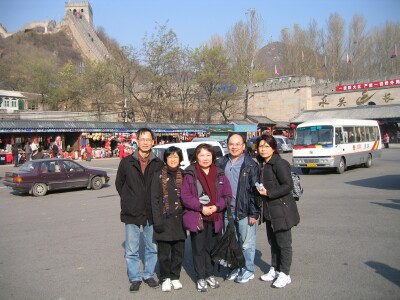
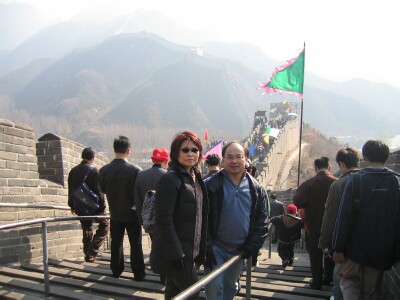 After everyone had descended
from the Great Wall,
we boarded our bus and headed to an enamelware factory
where the artists demonstrated the various stages of
their Cloisonne art creations. This enamelware is called
“Blue of Jingtai,”
as blue is the dominant color used for enamelling.
As the noon hour approached, we headed to
the Beijing Jindian
International Restaurant for lunch. We sampled
a 56%-proof liquor – it was quite tasty!
After an enjoyable lunch, Lucy
took us to see the Ming
Tombs, a general name given to the
mausoleums of the 13 emperors of the Ming Dynasty
(1368 - 1644). The mausoleums have been perfectly
preserved, as has the necropolis of each of the many
emperors. It was a sight for us to see, the
underground chambers of a historical, palatial
and integrated architecture.
Before
dinner, our tour bus rolled on to Tong-Ren-Tang, a
Beijing Pharmaceutical factory. After a short tour
through their hallway, the factory guide relayed the
herbal medicine history of China. In-house
herbalists checked our pulses and recommended that we
should take some of their herbal prescriptions,
according to their diagnoses. A few of us purchased
remedies. Our dinner location was inside this same
building. Our meal consisted of soups and dishes made
from their herbal formulas. During dinner, an
impressive acrobatic show was performed by their Beijing artists. We
returned to our hotel immediately after the show.
Sunday,
November 7th was another
sunny day. After breakfast, we proceeded to a pearl
factory where we saw all different types, colors, and
shapes of pearls, pearl jewelry, and pearl cosmetic
products. Most of the ladies in our group bought an
item or two. The men walked around the store for 15
minutes or so, waiting for them outside the factory.
Lucy then
took us to Tiantan,
The Temple
of Heaven. We were told that Tiantan
has served as a place of ceremony and ritual for the
Ming and Qing emperors. The Palace of Abstinence is located near the western
entrance of the temple. Before each ceremony, emperors
of the Ming and Qing dynasties held a three-day fast
during the summer and winter solstices. The emperors
spent two days fasting in the Forbidden City, and completed their third day
in the Palace of Abstinence. This beamless hall was one of
the most famous buildings in Beijing.
South of the Echo Wall stands the Altar of
Heaven, built entirely of white marble. The altar has
four entrances and a flight of nine steps leading down
in every direction. At the center of the upper terrace
lies a round stone, surrounded by nine concentric rings
of stones. A few of us tested the sound wave effects of
this echoing phenomenon.
We had a lamb, Hot Pot lunch at the famous Dong Lai Shun Restaurant.
After lunch, Lucy took us to the Beijing Capital Airport and arranged our next flight
to Shanghai ‑ we thanked for her
hospitality and service. We were all wishing that we
could have more time in Beijing to visit other historical
places…
Late that afternoon, we arrived at the Hongqiao Airport (old Shanghai Airport) and met our next tour guide,
Mr. George Shen. Mr. Shen was quite a funny character!
He explained why his previous tour groups teased him
about his name. He told the ladies that they may call
him “Ah Shen.” They all laughed, because with his
accent, “Ah Shen” was pronounced in a way that meant
“aunt” in a different dialect. He told us that we would
be heading to Suzhou first, then Hangzhou, and back to Shanghai.
Our bus traveled the endless highway for hours.
During the ride, George recounted an old Chinese
proverb: "In heaven
there is paradise, on earth there are Suzhou and Hangzhou." Suzhou is a major tourist city of
wide reputation located in the Jiangsu Province. It is an ancient and moated
city; however, it is also an open city with a developed
economy and frequent exchanges with the outside world.
George explained that Suzhou is famous for its gardens,
beautiful women, and silk. We finally
arrived at a Suzhou Restaurant after nightfall.
Fortunately, the restaurant was kept open for us. We
sampled Suzhou-style cooking while a songstress visited
our tables singing and playing her “Pi Pa.” Mr. Kin Man Yee and Mr. Wayne
Yee asked her to sing two more songs for us.
After dinner, our bus continued on to the Nanya
Hotel, where we stayed for two days. The hotel
staff brought our luggage to our rooms and George gave
us our next day’s itinerary.
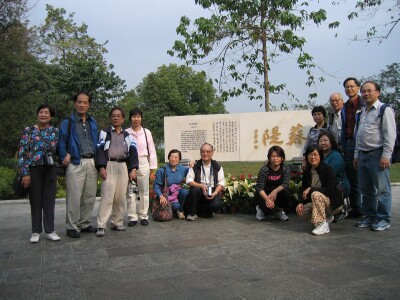 Monday, November 8th was another fine day. After our
Suzhou, continental-style breakfast,
we carried on to visit the Garden of the Master of the Nets.
Originally known as the Fisherman’s Retreat, it is the
smallest of the Suzhou residential gardens yet it is
the most impressive. The effective use of space creates
the illusion of an area that is much greater than its
actual size. Even more than the architectural
achievement is the mood of tranquility and harmony that
this humble garden embodies. We then visited the Hanshan Temple – formerly one of the ten most
famous temples in China. The poem of "A Night Mooring
by Maple Bridge" by Zhang Ji, a famous poet of
the Tang dynasty, is so oft-quoted and widely loved,
that its poetic rhyme and bell-tolling sounds have made
the Hanshan Temple celebrated at home and abroad.
Later that day, we went to the Tourist Trading Department
of Jiangsu Silk Research Institute. The tour
guide showed us how the cocoon covering the caterpillar
is extracted by hand. Cocoons are placed in hot water
and the silk filaments joined together to form a long,
continuous thread when wound on a reel. It’s amazing to
imagine that these tiny silkworms produce the fibers
that make such beautiful silk fabric.
We found the process very interesting. After touring the
Institute, we lunched at their third-floor restaurant.
Next, we moved on to the shopping complex where most of
us purchased silk quilts and quilt covers to take home.
We also watched a fashion show in the auditorium.
Suzhou is also known as the Venice of the East. We relaxed on a
boat ride through the Grand Canal, taking in its ancient
features and waterside villages. We also passed through
the ancient Panmen
Gate: the only well-preserved city gate in China with both land and water
gates. First built in the Warring States Period, the Grand Canal passes by the city wall and
this scenic area encompasses both a water country and
the ancient style of Suzhou city.
Tuesday, November 9th
after
breakfast, our tour bus passed through "Little Singapore,"
an entire industrial city built on the outskirts through
Singaporean investment. We visited the Suzhou Lanliyuan Cixiu
Yanjiusuo (Suzhou Embroidery Research
Institute) next, and their Embroideress fascinated us
with her embroidery masterpiece (Chinese: Cixiu) which has two different faces.
For example, one face might show a image of a kitten,
and then when you flip it around, the other side shows a
dog. There were many other examples of beautiful
handicrafts and artistic, silk tapestry to view.
We headed toward Hangzhou, which was a two-hour drive
from Suzhou, arriving around 12:30pm. We met our next tour guide,
Mr. Tung Yi, at the restaurant for lunch. George
explained to us that Mr. Tung is more familiar with the
area since he is a native of Hangzhou. We visited the Linying Temple ‑ the temple for the soul’s
retreat ‑ one of the most famous Buddhism temples in China. After an hour or so of
sightseeing at the temple site, we proceeded to our
hotel, the Ramada Plaza Hangzhou.
We dined in a private room at the Hangzhou Hong Ni Garden
Restaurant, where they served us some of Hangzhou’s finest cuisine. It was worth
the extra $68 RMB each, to sample their specialty of
Dazha crabs. This specialty is advertised as follows:
"Yellow hair, golden claw, green shell, white belly and
heavy weight" which describes the unique characteristics
of these Yangchenghu Crabs. "September female and
October male" is the secret for tasting. Yangchenghu
Dazha Crabs means female crabs in September have rich
and hard ovaries. Male crabs in October are rich in fat.
Mind you, as these crabs are rich in cholesterol, we
would not recommend that you eat too many of them!
Wednesday, November 10th
we got up
early ‑ the sky was a bit cloudy. Rain must have fallen
during the night as the ground was a bit wet. Luckily,
it was not raining anymore. After breakfast, we passed
through a pond full of colorful carps and then took a
boat ride on the West Lake. This is a manmade lake
located in the middle of the city. Mr. Tung said if we
have ever watched The
Legend of White (and Green) Snake, we might notice
that this lake was the meeting place of the two lovers.
He also pointed out several other famous scenic areas.
We visited the Mei Jia Wu Tea Village,
famous for its Longjing (Dragon Well) tea. Mei
Jia Wu Long Jing has very light nutty aroma but made up
for it with its very smooth and delicate taste and a
pleasant flowery aftertaste. This tea is recommended to
tea drinkers who prefer light and delicate flavored tea.
Most of us bought these flat, slender strips of tea
leaves in small containers. Ms. Mei, our host at the Mei
Jia Wu Long Jing, was a well-educated woman who is a
descendant of the Tea Village family. She’s also an excellent sales person,
I might add!
After lunch, Mr. Tung took us
to the 13-storey-high,
Six Harmonies Pagoda site. Dating from 970 and
built on the site of an earlier pagoda that served as a
lighthouse, the name refers to the six codes of Buddhism
i.e. harmony of the body, speech and thought, and the
renunciation of personal pleasure, opinions, and wealth.
We returned to our hotel for a
short rest before dinner. Mr. Tung asked us if we would
like to sample the Hangzhou famous Duck Soup (for an extra
$80 RMB each) at the Zhang Sheng Ji Hotel Restaurant. We all agreed. Since we
traveled from across the Pacific Ocean to enjoy this trip ‑ we were
happy to experience some, if not all of the authentic,
Chinese cuisine. The food was delicious and well worth
the price.
We all went for a walk down the
West Lake after dinner.
Thursday, November 11th
we had
breakfast and met George at the hotel lobby. Climbed on
to our bus and headed for Shanghai. Shanghai, called "Hu" for short, is a
bustling metropolis located at the mouth of the Yangtze River. Connected with Jiangsu and Zhejiang provinces to the west, the
city is exposed to the East
China Sea to its east. We arrived in Shanghai around noon. Shanghai’s vast skyline was filled with
skyscrapers and bridges.
It was off to the Shanghai Zi Jin City
Shopping Center’s Restaurant for lunch. The
food was excellent and quite tasty.
After lunch, we went to visit
the Yu Garden
and its shopping bazaar. Yu Garden is a place of peace
and comfort in the heart of bustling Shanghai and dates back to the fabled
Ming Dynasty.
Next, we visited The Bund (also
called the Zhongshan Road). This is a famous waterfront
and has been regarded as the symbol of Shanghai for hundreds of years. It’s
definitely one of Shanghai's major, sightseeing
highlights. Pu Dong, on the other side, now houses the
headquarters of major banks and corporations. As we
walked along the Bund, which is at the west shore of the
Huangpu River, the futuristic Oriental Pearl TV Tower
can be seen across the river. The weather was picture
perfect; all of us took photos there.
After dinner, we strolled down
Nan Jing Road. Once, Shanghai's major shopping street, this
exciting avenue is lined with well-known shops and
department stores selling clothing, food and specialty
goods. It still proves worth visiting, especially at
night in its full, neon-lit glory. We stayed at the
Holiday Inn Vista Shanghai.
Friday, November 12th was a free day. We met our
friends, Fred and Clara Yee from Seattle, around 8:30am in our Hotel lobby. This
meeting was planned months ago, while still in Vancouver. Seven of us from Vancouver, rode in a company van
(courtesy of the husband of Clara’s, Shanghai-friend).
We were driven to the Zhouzhuang water village.
This village is noted for its profound cultural
background, the well-preserved, ancient residential
houses, elegant water views and the strong,
locally-colored traditions and customs. We spent almost
half a day there.
The driver returned us to Fred’s hotel, where the
men were discussing the meeting agenda on the upcoming
Yee convention and the ladies were out shopping till the
late afternoon. We went for dinner at the Old Shanghai Restaurant.
After dinner we all took a taxi back to our hotel except
Kitty; she went out with Clara and Fred to see the night
scene at the Oriental Pearl TV Tower.
Saturday, November 13th after breakfast, George took us
to Shanghai’s new Pu Dong International
Airport. We thank George for his excellent
services. Again, we all wished that we had more time
to spend in Shanghai to visit
other major attractions… We were about to depart this
famous city to attend the Yee Convention. Time flew by
so swiftly, only memory of this unforgettable trip
will linger in our minds. Who knows? We may come back
and visit China again in
another time.
We flew and arrived at the Hong Kong International Airport around 1:45pm. The Hong Kong Yee
representatives met us to drive us to our hotels. We
stayed at the Stanford Hillview Hotel.
Later that evening,
my sister, Kitty and I went out for dinner with Kitty’s
old classmate, Mr. Wen Kay and his wife; they are
a very nice couple.
We all looked forward for our next few days'
itinerary arranged by our Hong Kong cousins.
As to the happenings of the Yee’s Convention from
November 14th to November 16th?
Well, that’s another story…
Now, on behalf of my wife,
and my sister, I would like to thank Mr. Wing Yee, Mr. Jim Yee and the YFT society of Vancouver for arranging this fantastic
trip for all of us. We all had a wonderful time...
Thanks. We would also like to thank Clara and
Fred Yee for taking us to visit the Zhouzhuang water village. And special
thanks to Ms Nancy Nesbitt; who helped me by
reviewing and editing this article.
|
|




